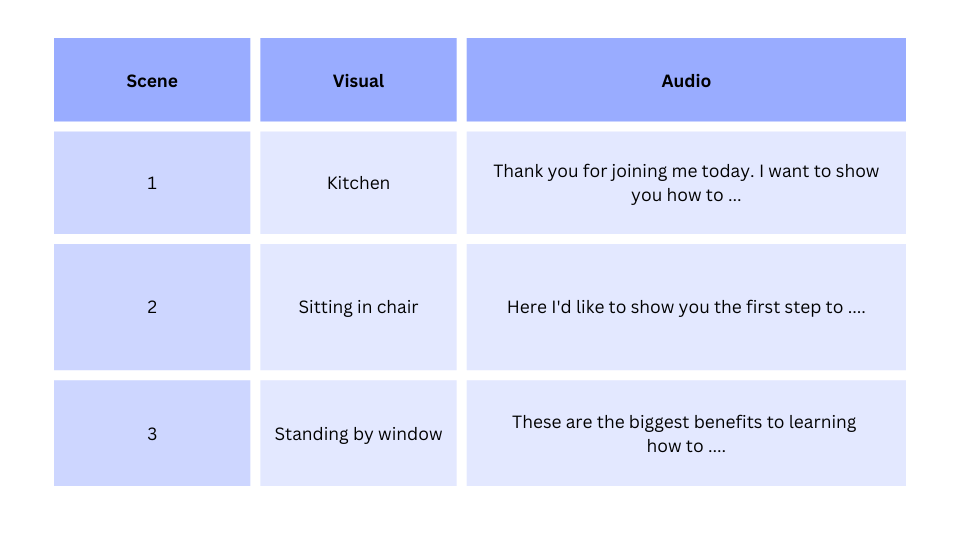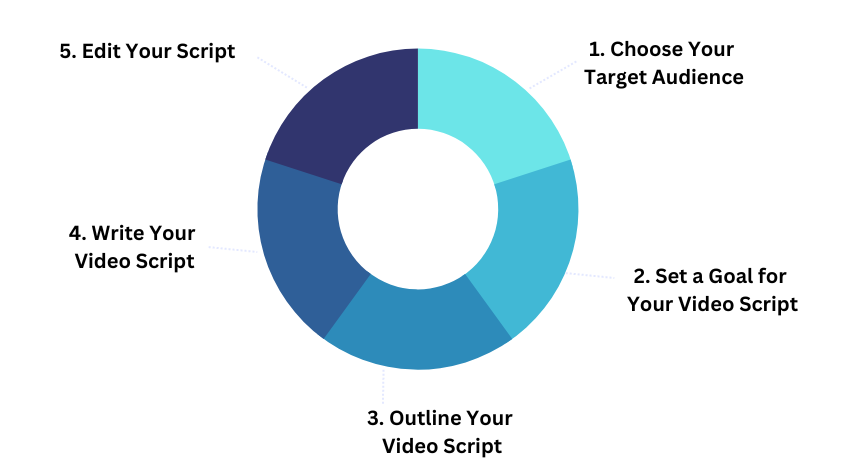Our content is reader supported, which means when you buy from links you click on, we may earn a commission.
5-Steps to Writing a Video Script (w/Templates)

Are you ready to write a video script? Writing a script for a video can be challenging, especially if you’ve never written one before.
I’ve been creating videos since about 2004 and always write a script beforehand. It helps keep the video on track and focused on the main goal. Scripted videos are usually more engaging for your audience as well.
In this guide, I’ll outline the components that make up an effective video script. I’ll also provide tips for writing your own video script.
Whether you’re just starting out making videos or want to improve your current process, read on!
What is a Video Script?
A video script is a blueprint or foundation for your digital video.
 Video scripts help keep track of what needs to happen in your video and how long each part should take. Having a script written out beforehand helps you create an engaging storyline. That means you stand the chance of creating an effective video campaign that connects with your target audience more often by using a script.
Video scripts help keep track of what needs to happen in your video and how long each part should take. Having a script written out beforehand helps you create an engaging storyline. That means you stand the chance of creating an effective video campaign that connects with your target audience more often by using a script.
Scripts include a description of each scene, as well as the dialogue, narration, and other audio elements. The script also indicates the timing and placement of these elements within the video.
A video script is essential for ensuring that all aspects of the production come together seamlessly. Without a script, it would be difficult to properly plan and execute a video shoot. In addition, the script can serve as a valuable reference during post-production, when the video is being edited and assembled.
There are many ways to approach video scripting, but we recommend starting with a simple video outline before diving into production.
Create Videos that Drive Action
When it comes to videos, it’s not just about going viral.
We all know videos that get a lot of views and are shared widely can be great for raising awareness about your cause. But if you want to create videos that inspire people to take action, you need to go further than just getting lots of views.
You need to create videos that tell a story and connect with viewers on an emotional level. Scripting helps you think about your message and what you want to convey.
Videos that make people laugh, cry, or feel angry are more likely to inspire them to take action than videos that are simply entertaining. So if you want to create videos that drive action, focus on telling a story that will resonate with your audience.
Focus on Your Call-to-Action
As any good marketer knows, the call-to-action (CTA) is one of the most important elements of any video.

Studies have shown that CTAs within videos get more than 3 times the number of clicks than CTAs on a sidebar.
The CTA is what tells viewers what you want them to do next – whether it’s signing up for your email list, downloading a white paper, or making a purchase. That’s why your call to action should be clear and concise.
And while it’s important to have a strong CTA throughout your video, it’s especially crucial to focus on your CTA at the end. That’s because viewers are more likely to take action after they’ve watched a video all the way through, and they’re also more likely to remember your CTA if it’s the last thing they see.
How to Write Your Video Script
There’s no single right way to write a video script. The most important thing is to keep your audience in mind and communicate your message clearly. The following list includes a few tips to help you write an engaging video script:
- Keep it concise. Write in short, punchy sentences that can be easily understood.
- Be clear and straightforward. Don’t try to be too clever or cute – just get to the point.
- Write for the visuals. Describe what the audience will see on their screen, and keep the dialogue to a minimum.
- Know your audience. Write for the people who will be watching your video, and tailor your message accordingly.
We’ve broken the video script writing process into 5 major steps. These steps include:
- Choosing Your Target Audience
- Setting a Goal for Your Video Script
- Outlining Your Video Script
- Writing Your Video Script
- Editing Your Script
 Here are detailed tips on each step in the video script writing process:
Here are detailed tips on each step in the video script writing process:
1. Choose Your Target Audience
Before you develop characters or a brief for a video, you need to know who your video is for. Your video could be for existing customers, new prospects, or a general audience.
This is all part of planning your video.
A good way to narrow down your target audience is through research. You may want to do research especially if it’s a sales video. In this case, a buyer persona is an imaginary character designed to represent your ideal customer. Your buyer persona helps you understand what type of audience you’re trying to reach.
No matter what type of video you’re creating, identifying your target viewer before you write your script is critical to making sure you connect with them. Decide exactly who your video is for before you write anything.
You should consider the following:
- What’s the age range of your target audience?
- What’s their gender?
- Where do they live?
- What’s their income level?
- What do they do for a living?
- What are their interests?
- What’s their level of education?
By understanding your target audience, you can develop a script that appeals to them specifically. It will help you know the right language to speak.
When you spend the time to uncover your audience, those behaviors and interests you uncovered can help you know what’s important to them. This research can also help you uncover the exact words to use. Sometimes that includes industry jargon and other times it requires you to speak very conversationally which may even include slang.
No matter who you’re speaking to, it’s best to write your video script informally. Don’t speak in an overly formal manner. You’ll want your script to sound natural. One way to accomplish this is to use real words and phrases that people actually say. Write as you speak. Best of all, don’t just copy someone else’s style – find your own voice.
2. Set a Goal for Your Video Script
Before you start writing, it’s important to know what you want your video to achieve.

Your goal could be to:
- Generate leads
- Introduce a new product
- Boost sales of an existing product
- Increase brand awareness
- Educate your audience about a topic
- Get people to sign up for your email list
- Drive traffic to your website
Your goal will determine the tone and approach to take in your script. Start your video by asking yourself why you’re creating the video. Think about the problems you’re trying to solve and once again, about the audience you’re targeting.
3. Outlining Your Video Script
Outlining a video script is an important step in the video production process. It allows you to organize your thoughts and ideas, and ensure that your video flows smoothly from start to finish.
There are a few different ways to approach outlining a script. One method is to simply write down a list of the topics you want to cover in your video. Another approach is to create a more detailed outline, which includes specific scenes and shots.
Whichever method you choose, the goal is to have a clear roadmap for your video before you begin filming. Outlining your script will save you time and hassle in the long run, and will help you create a more polished and professional final product.
4. Writing Your Video Script
Writing a video script may seem like a daunting task, but it’s probably easier than you think.
Just like any other piece of writing, a video script should have a beginning, middle, and end. The beginning should introduce the viewer to the topic of the video, while the middle should provide more detail and context. The end should wrap up the video and leave the viewer with a clear takeaway.
Turn Your Message into a Story
Stories are great ways to convey information. A well-told story can help people understand what you’re saying in a very impactful way. In part, that’s because people are more likely to remember a story than a list of facts. In addition, stories are very engaging (especially when compared to a list of facts).

Stories don’t need to be complex, but they do need to be logical and compelling. Make sure your story is relevant to your target market. And then tell stories that guide people through your brand.
Be Conversational
Writing scripts isn’t the same as creating a college paper or marketing report. You’ll want to avoid long sentences and complex words. In addition, you should probably avoid jargon and buzzwords (unless your target audience really uses them).
Write in Short Paragraphs
Short paragraphs make it easy to read and understand your script. In fact, they often have a dramatic effect that helps place extra emphasis on each statement. In this way, they keep your viewer’s attention.
A good rule of thumb is to keep each paragraph under 4 sentences. Keep each sentence to under 20 words. The shorter each sentence within a paragraph is, the better.
Keep it Short and Sweet
A good rule of thumb is to keep your scripts under 5 minutes, but this can depend on the goal of the video. Even when I’m creating an instructional video I aim for under 5 minutes.
That way, each video is focused on one learning objective. You will want sales videos to definitely run under 5 minutes. To accomplish this, you’ll need to sacrifice things that aren’t essential to convey the message.
Another way to keep your videos short is to make sure not to repeat yourself.
5. Edit Your Script
Once you have your script written, it’s time to edit it.
This will help make sure it’s engaging and error-free. Even though it’s not a college paper, you still want to review it for grammar, punctuation, and spelling mistakes. Keeping it error-free will help the performance smoothly when it comes time to film.
Edit your video script to ensure that it flows smoothly and logically from one point to the next. Transition words and phrases can help to achieve this.
Also, check that your video script is the appropriate length for the video format you are using. For example, a two-minute video will require a shorter script than a ten-minute video. As a rule of thumb, one minute of video is about 160 to 220 words.
Make sure the content is focused and relevant to your audience. Cut out unnecessary details and fluff. You don’t want to waste too much time on unnecessary parts of your script.
Read Your Script Out Loud
If you’re working on a video project, one of the best things you can do is read your script out loud. This will help you catch any errors or awkward phrasing, and it will also give you a better sense of the flow of the piece. Additionally, reading your script aloud will help you get a feel for the rhythm and cadence of the piece, which is essential for creating an engaging video.
You can take it further by recording yourself while reading it. Recording yourself will help you see how well your message comes across.
If you can, have someone else read your script out loud to catch errors.
Once you’ve finished reading, take a break and come back to it later. This will allow you to see if there are any other problems you missed.
Make it Flow
When reading your script out loud, you’ll notice words that aren’t flowing well. Make changes to your script after reading it out loud.
Video Script Templates
Informational Videos
Educational videos should be concise and visual. A good presentation script includes a brief introduction, main points, conclusion, call to action, and other important details. You will want to use images and animations to add value to your educational videos.
Informational video script templates typically have the following parts:
- Introduction – This should include a brief overview of the topic, as well as the goal of the video.
- Main Points – This is where you will include the main points of the video. These should all lead back to the goal. For instance, if your video explains intermittent faster, then you may need to have a definition of what it is with 3 benefits of why they want to give this method of weight loss a try.
- Graphics and Animation – If your video includes any visuals, make sure you include them throughout the video. If you’re doing a talking head video, you can appear next to the graphics or a presentation or you can transition from you to the visuals.
- Closing – This should recap the main points made in the video, as well as thank viewers for watching. Tell them where to go next and that you’ll see them in that next video!
Explainer Videos
These short videos use motion graphics, animated images, and simple voiceovers to clearly explain a concept or idea in an easily digestible way. Explainer videos can be used for a wide variety of purposes, from teaching people how to use a product or service to help customers understand complex concepts like financial planning or business strategy.
Here is how the typical explainer video will often flow:
- Introduce the company and the problem it solves.
- Explain the product or service in simple terms.
- Show how the product or service works.
- Outline the benefits of using the product or service.
- Call to action.
Product Videos
Product videos are a great way to engage potential customers and showcase your product in action. Whether you have a new technology gadget, a fashion accessory, or some other type of consumer good, creating an engaging product video can help drive interest and sales.
Here is how a product video might flow:
- Introduce the product.
- Show how the product works.
- Highlight the benefits of the product. This is where you would spend the most time. Benefits always help sell products.
- Explain why the product is valuable.
- Include a call to action.
Frequently Asked Questions on Video Scripts
What is a video script format?
There’s no one right video script format, but there are a few general guidelines you can follow to make sure your video is engaging and easy to follow:
- Start with a brief introduction that sets the scene and explains what the video is about.
- Include a series of short, concise scenes that illustrate your point.
- End with a summary or call to action that ties everything together.
Remember to keep your language clear and simple throughout, so that your audience can easily understand what you’re trying to say.
How do you start a script?
First, you need to have a clear idea of what your story is about. What’s the main conflict? What are the stakes?
Once you know what your story is about, you need to start thinking about your characters. Who are the protagonists and antagonists? What motivates them? How do they interact with each other?
Start your script off with a bang.
How do you write a 60-second script?
Writing a 60-second script is all about getting your point across quickly and effectively. Here are a few tips to help you get started:
- Start with a strong hook. You need to grab your audience’s attention from the very beginning, so make sure your opening is strong and engaging.
- Keep it concise. Every word in your script should serve a purpose, so avoid any unnecessary fluff.
- Use active language. Verbs like “grab” or “engage” are more powerful than passive phrases like “is seen” or “is heard.”
- Write for the ear, not the eye. Remember that your script will be read aloud, so write in a way that sounds natural when spoken.
How do you write a killer video script?
Before you can write a killer video script, you need to understand what makes a great video. What is it that will engage your audience and keep them watching? What are the key points that you want to communicate?
Once you have a clear understanding of your goals, you can begin to write your script. Keep in mind that a great video is more than just a collection of footage; it has a beginning, middle, and end. It tells a story. And it does so in an engaging and visually interesting way. So take some time to brainstorm and come up with an outline for your script. Then, start putting your story down on paper.
How many pages is a 1-minute script?
If you’re using standard screenplay format, then one page equals approximately one minute of screen time. However, if you’re using a more condensed format, then you may be able to fit more than one minute of screen time on a single page.
What are the three components of video planning?
Before you start filming your next project, it’s important to take the time to plan everything out. This is especially true for video projects, where a lot of moving parts need to come together in order to create a cohesive final product. When planning a video, there are three main components that you need to keep in mind: story, shots, and sound.
- The story is the foundation of your video – it’s what will engage your viewers and keep them watching until the end.
- Shots are the individual pieces of footage that you’ll be using to tell your story.
- Sound is an important element that can often make or break a video.
Why is planning a video project important?
Any video project, no matter how big or small, requires careful planning in order to be successful. Without a clear plan, it can be difficult to stay on track and budget for the project, which can lead to problems down the road.
In addition, a good plan helps to ensure that everyone involved in the project is on the same page and knows what their roles and responsibilities are. By taking the time to plan out your video project ahead of time, you can avoid a lot of headaches and set yourself up for success.
The Bottom Line
The next step is to put all of this into practice and start writing your video script. Remember to keep it simple and focus on the most important points you want to make.
Once you have your script written, don’t forget to storyboard it so you can visualize how the video will look when it’s finished.
If you’re ready to create videos that sell, then make sure to start with the video script. Get going with it now!